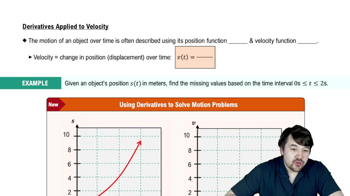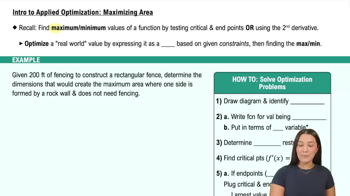Cylinder and cones (Putnam Exam 1938) Right circular cones of height h and radius r are attached to each end of a right circular cylinder of height h and radius r, forming a double-pointed object. For a given surface area A, what are the dimensions r and h that maximize the volume of the object?
Table of contents
- 0. Functions7h 54m
- Introduction to Functions16m
- Piecewise Functions10m
- Properties of Functions9m
- Common Functions1h 8m
- Transformations5m
- Combining Functions27m
- Exponent rules32m
- Exponential Functions28m
- Logarithmic Functions24m
- Properties of Logarithms36m
- Exponential & Logarithmic Equations35m
- Introduction to Trigonometric Functions38m
- Graphs of Trigonometric Functions44m
- Trigonometric Identities47m
- Inverse Trigonometric Functions48m
- 1. Limits and Continuity2h 2m
- 2. Intro to Derivatives1h 33m
- 3. Techniques of Differentiation3h 18m
- 4. Applications of Derivatives2h 38m
- 5. Graphical Applications of Derivatives6h 2m
- 6. Derivatives of Inverse, Exponential, & Logarithmic Functions2h 37m
- 7. Antiderivatives & Indefinite Integrals1h 26m
- 8. Definite Integrals4h 44m
- 9. Graphical Applications of Integrals2h 27m
- 10. Physics Applications of Integrals 3h 16m
- 11. Integrals of Inverse, Exponential, & Logarithmic Functions2h 31m
- 12. Techniques of Integration7h 41m
- 13. Intro to Differential Equations2h 55m
- 14. Sequences & Series5h 36m
- 15. Power Series2h 19m
- 16. Parametric Equations & Polar Coordinates7h 58m
5. Graphical Applications of Derivatives
Applied Optimization
Problem 4.5.65
Textbook Question
Crankshaft A crank of radius r rotates with an angular frequency w It is connected to a piston by a connecting rod of length L (see figure). The acceleration of the piston varies with the position of the crank according to the function <IMAGE>
a (Θ) = w²r (cos Θ + (r cos2Θ) / L) .
For fixed w , L, and r find the values of Θ, with 0 ≤ Θ ≤ 2π , for which the acceleration of the piston is a maximum and minimum.
 Verified step by step guidance
Verified step by step guidance1
First, understand that the problem involves finding the extrema (maximum and minimum values) of the function a(Θ) = w²r (cos Θ + (r cos²Θ) / L) with respect to Θ, where 0 ≤ Θ ≤ 2π.
To find the extrema, we need to take the derivative of a(Θ) with respect to Θ. This involves using the chain rule and product rule for differentiation.
Set the derivative, da/dΘ, equal to zero to find the critical points. These are the values of Θ where the acceleration could be at a maximum or minimum.
Evaluate the second derivative, d²a/dΘ², at the critical points to determine the nature of each critical point (i.e., whether it is a maximum, minimum, or a point of inflection).
Finally, evaluate the original function a(Θ) at the critical points and the endpoints Θ = 0 and Θ = 2π to determine the absolute maximum and minimum values of the acceleration within the given interval.
 Verified video answer for a similar problem:
Verified video answer for a similar problem:This video solution was recommended by our tutors as helpful for the problem above
Video duration:
7mPlay a video:
Was this helpful?
Key Concepts
Here are the essential concepts you must grasp in order to answer the question correctly.
Angular Motion
Angular motion describes the rotation of an object around a central point or axis. In this context, the crankshaft rotates with an angular frequency, denoted by ω, which is the rate of change of the angular position θ over time. Understanding angular motion is crucial for analyzing how the crankshaft's rotation affects the piston's movement.
Recommended video:

Derivatives Applied To Velocity
Trigonometric Functions
Trigonometric functions, such as cosine, are essential in describing periodic phenomena like rotational motion. In the given function a(Θ) = ω²r (cos Θ + (r cos2Θ) / L), the cosine terms represent the angular position's influence on the piston's acceleration. Mastery of trigonometric identities and properties is necessary to manipulate and analyze these expressions effectively.
Recommended video:

Introduction to Trigonometric Functions
Optimization in Calculus
Optimization involves finding the maximum or minimum values of a function, which is a common application of calculus. To determine the values of Θ that maximize or minimize the piston's acceleration, one must use techniques such as taking derivatives and setting them to zero to find critical points, then applying the second derivative test or analyzing endpoints within the given interval.
Recommended video:

Intro to Applied Optimization: Maximizing Area

 1:13m
1:13mWatch next
Master Intro to Applied Optimization: Maximizing Area with a bite sized video explanation from Patrick
Start learningRelated Videos
Related Practice
Textbook Question
